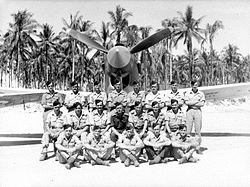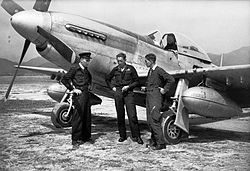- No. 81 Wing RAAF
-
No. 81 Wing RAAF 
No. 81 Wing's crestActive 1944–current Country Australia Branch Royal Australian Air Force Role Air superiority Part of Air Combat Group Headquarters RAAF Base Williamtown Motto Prepared to Fight Commanders Notable
commandersGordon Steege (1944)
Wilfred Arthur (1945)
Brian Eaton (1947-48)Aircraft flown Fighter F/A-18 Hornet No. 81 Wing RAAF (2008)Components No. 81 Wing is the Royal Australian Air Force's air superiority wing. Formed during World War II, it operated in the South West Pacific theatre, flying P-40 Kittyhawks. Following the end of hostilities, it converted to P-51 Mustangs and was based in Japan as part of the Allied occupational forces. In the 1960s it began operating jets, firstly the CAC Sabre, and later the Dassault Mirage III. Detachments of these fighters saw extensive overseas deployment in Thailand and Malaysia. The wing is currently headquartered at RAAF Base Williamtown, New South Wales, and operates three combat squadrons and an operational conversion unit flying the F/A-18 Hornet. The Hornets saw action in the 2003 invasion of Iraq, providing fighter escort and close air support to Coalition forces.
Contents
History
World War II
No. 81 Wing was established in the latter half of World War II and operated P-40 Kittyhawk fighters in the South West Pacific theatre. Comprising Nos. 76, 77 and 82 Squadrons, it joined Nos. 77 and 78 Wings on Noemfoor as part of No. 10 Operational Group in September 1944, under the command of Group Captain Gordon Steege.[1] No. 10 Group was renamed the First Tactical Air Force (No. 1 TAF) in October;[2] the same month, No. 81 Wing commenced operations with offensive sweeps and ground attacks against targets in West Papua.[3]
The relegation of No. 1 TAF to areas of operation bypassed by the main Allied thrust towards the Philippines and Japan led to poor morale late in 1944. In December, No. 81 Wing's new commander, Group Captain Wilfred Arthur, produced a "balance sheet" to demonstrate that the unit's results were not worth the cost in ordnance and casualties, setting in train a series of events that would culminate in the so-called "Morotai Mutiny" the following year.[4][5] By January 1945, the number of missions flown by No. 81 Wing had dropped to less than 400, from over 1,000 the previous month.[4] In March, the Kittyhawks carried out some 80 patrols around Noemfoor but encountered enemy activity on less than half of these.[6] No. 81 Wing was slated to take part in Operation Oboe One, the Battle of Tarakan, in May 1945 but was unable to move from Noemfoor to its new base on Morotai in time. It fought in Operation Oboe Six, the invasion of Labuan, from June 1945 and was based on the island when the Pacific War ended in August.[7] During the Labuan operation No. 457 Squadron, which was equipped with Spitfire fighters, was attached to No. 81 Wing.[8]
Post-war years
No. 81 Wing began re-equipping with P-51D Mustangs in September 1945, under the leadership of Wing Commander Glen Cooper. Headquartered at Bofu, a former kamikaze base, it formed the Australian air contingent of the British Commonwealth Occupation Force in Japan from 1946 until 1949, when the RAAF presence was reduced to No. 77 Squadron alone. The first of the wing's units to arrive in Japan was No. 5 Airfield Construction Squadron (No. 5 ACS) in December 1945, followed by the three flying squadrons in February-March 1946. No. 82 Squadron lost three Mustangs and a de Havilland Mosquito in bad weather en route to Bofu in March, killing all crew members. The wing's strength was augmented later in 1946 by No. 481 (Maintenance) Squadron and No. 111 Mobile Fighter Control Unit. With no serious resistance to the Allied occupation, the wing's prime operational duty was surveillance patrols. However the RAAF personnel helped maintain law and order, and supervised elections, while No. 5 ACS, in addition to military construction, contributed to rebuilding local infrastructure.[9] Group Captain Brian Eaton took command of the wing in 1947.[10] No. 82 Squadron disbanded in Japan in October 1948,[11] while No. 76 returned to Australia, later becoming part of a reformed No. 78 Wing when it deployed to Malta in 1952.[12][13]
The wing was reorganised at RAAF Base Williamtown, New South Wales in January 1960. Flying CAC Sabres, its complement included Nos. 75 and 76 Squadrons, as well as No. 2 Operational Conversion Unit (No. 2 OCU). Eight of the wing's aircraft were detached to Ubon, Thailand in June 1962, eventually reforming there as No. 79 Squadron.[14] In September 1964, Nos. 76 and 481 Squadrons were deployed to RAAF Base Darwin, Northern Territory, as part of Operation Handover, a little-publicised contingency plan put into effect during the Indonesia-Malaysia confrontation. No. 76 Squadron's Sabres, armed with Sidewinder missiles, were to defend against possible attack by Indonesian forces following the recent establishment of the Federation of Malaysia. This was the first time since World War II that an RAAF flying squadron was positioned "in harm's way" on Australian territory. The Officer Commanding No. 81 Wing, Group Captain A.F. Mather, took on the role of Area Air Defence Commander. Although no combat ensued, the experience revealed deficiencies in the defence of Northern Australia and contributed to the decision to maintain a permanent detachment of No. 81 Wing fighters in Darwin, and later at RAAF Base Tindal.[15][16]
The wing converted from Sabres to Dassault Mirage IIIs during 1964–66, commencing with No. 2 Operational Conversion Unit and concluding with No. 76 Squadron; the last-mentioned disbanded in 1973.[17] No. 75 Squadron was based at RAAF Base Butterworth, Malaysia from 1967 until 1983, when it relocated to Darwin. Following conversion to the F/A-18 Hornet, the unit transferred to Tindal. By this time, in addition to No. 75 Squadron, No. 81 Wing comprised Nos. 3 and 77 Squadrons, based at RAAF Williamtown with No. 2 OCU, all which had converted from the Mirage to the Hornet in 1985–87.[18] For many years part of RAAF Air Command's Tactical Fighter Group (TFG), the wing became part of Air Combat Group when TFG merged with Strike Reconnaissance Group in February 2002.[19] The following year, No. 75 Squadron deployed to the Middle East to support the invasion of Iraq, escorting high-value Coalition aircraft and later providing close air support to ground troops and air interdiction against Iraqi forces, the first time the RAAF had delivered bombs in anger since the Vietnam War.[20]
Notes
- ^ Odgers, Air War Against Japan, p.249
- ^ Odgers, Air War Against Japan, p.299
- ^ Odgers, Air War Against Japan, pp.304,308
- ^ a b Odgers, Air War Against Japan, pp.386-390
- ^ Odgers, Air War Against Japan, pp.443-450
- ^ Odgers, Air War Against Japan, p.398
- ^ Odgers, Air War Against Japan, pp.466-473
- ^ Waters, OBOE - Air Operations Over Borneo 1945, p.110
- ^ Stephens, The Royal Australian Air Force, pp.213-216
- ^ Coulthard-Clark, Air Marshals of the RAAF, p.34
- ^ No 82 Squadron at RAAF Museum. Retrieved on 30 November 2010.
- ^ No 76 Squadron at RAAF Museum. Retrieved on 30 November 2010.
- ^ Stephens, The Royal Australian Air Force, pp.221-223
- ^ CAC Sabre at RAAF Museum. Retrieved on 30 November 2010.
- ^ "Operation Handover" – Darwin, September 1964 at Australian War Memorial. Retrieved on 30 November 2010.
- ^ Fighters Ready to Confront Threat at Air Force News. Retrieved on 30 November 2010.
- ^ Dassault Mirage III at RAAF Museum. Retrieved on 30 November 2010.
- ^ F/A-18 Hornet at RAAF Museum. Retrieved on 30 November 2010.
- ^ Set to Fly at Air Force News. Retrieved on 30 November 2010.
- ^ The War in Iraq. ADF Operations in the Middle East in 2003 (pp.26–28) at Department of Defence. Retrieved on 2 December 2010.
References
- Coulthard-Clark, Chris (1995). Air Marshals of the RAAF 1935–1995. Canberra: Department of Defence (Air Force Office).
- Odgers, George (1968) [1957]. Australia in the War of 1939-1945: Series Three (Air) Volume II – Air War Against Japan 1943-45. Canberra: Australian War Memorial. http://www.awm.gov.au/histories/chapter.asp?volume=27.
- Stephens, Alan (2006) [2001]. The Royal Australian Air Force: A History. London: Oxford University Press. ISBN 0195555414.
- Waters, Gary (1995). OBOE - Air Operations Over Borneo 1945. Canberra: Air Power Studies Centre. ISBN 0642225907. http://airpower.airforce.gov.au/Publications/Details/216/OBOE---Air-Operations-Over-Borneo-1945.aspx.
External links
Categories:- RAAF wings
Wikimedia Foundation. 2010.



